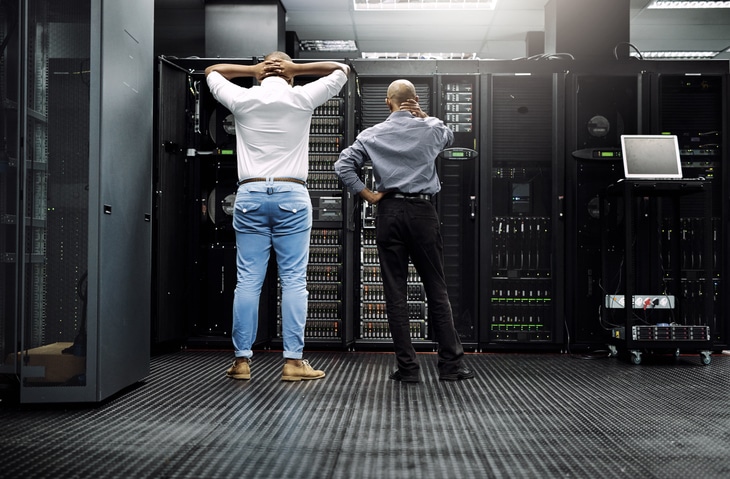At Red8, we surround ourselves with incredibly talented, well-rounded, and innovative engineers who continue to educate themselves as new trends emerge. We consult externally to provide a service, but we consult internally with each other to stay at the top of our tech-trends “A-game.” Having polled our team of engineers, we found hyperautomation, cybersecurity mesh, and quantum computing to be the technology trends most interesting for 2022.
1. Hyperautomation
The idea of hyperautomation involves organizations using multiple advanced technologies like artificial intelligence (AI), machine learning (ML), robotic process automation (RPA/bots), and many others to automate every possible task they can. Just like traditional IT automation, hyperautomation has similar goals:
- Enhance efficiency
- Boost productivity
- Cut costs
- Discover new processes and opportunities
- Increase scalability and flexibility
Two key factors to these goals are intelligent and advanced technologies. So what are some of the functions AI/ML and RPA can perform? RPA can create a list of actions for automating a task by watching how it is performed. These bots can handle tasks amongst multiple apps, from receiving and extracting data to inserting/importing it into the appropriate data system. Once that data is in the system, AI/ML models can process and analyze it against historical and existing external data to identify patterns and behaviors. All this is done without human intervention to free up resources and reduce operational costs. With more resources at their disposal, companies adopting this approach are more likely to gain a competitive advantage. Coupled with intelligence, the combination and collaboration of these advanced technologies is what elevates hyperautomation. These tools are dynamic as they can discover new ways to improve your company, conceive optimized procedures for automation, and generate bots to automate those procedures. So automating undocumented or dynamic processes that rely on unstructured data inputs is now a possibility. Its needed Before, automating undocumented or dynamic processes that rely on unstructured data inputs was unthinkable, but with hyperautomation is now a possibility
2. Cybersecurity Mesh
Cybersecurity mesh focuses on decentralizing information security along with identity management. Traditionally in cybersecurity, organizations rely on a single security perimeter wall around their networks to keep bad actors out. Depending on the operations of an organization, this can still be the most optimal way to practice cybersecurity. With the increase of remote working in 2020, we also see a rise in external security risks outside of the single security perimeter wall. In the case of cybersecurity mesh, organizations instead will rely on many security zones, all communicating and authenticating with each other. One issue with traditional security is IoT devices. These devices remotely access the central networks and have limited computing power and storage capacity. This means they can’t be trusted to run complex applications like antivirus software or anti-malware tools. They also don’t have enough memory to store large amounts of data. These limitations mean that IoT devices need an extra layer of security to ensure their safety from malicious attacks. The cybersecurity mesh provides this additional protection. It consists of two main components: edge nodes and core nodes. Edge nodes are small devices that connect to IoT devices and act as gateways between devices and the rest of the network. Core nodes are larger devices that provide connectivity between different networks. Together, these nodes make devices more secure by creating barriers between the networks they are connected to and encrypting communications between devices.
3. Quantum Computing
As a brief, simple overview of an immensely complicated subject, quantum computing is defined as the next generation of digital computation. Most importantly this technology utilizes quantum physics – primarily going against the idea that something cannot exist in 2 places at once – to perform vast amounts of complex computations much faster than conventional computer systems we’re used to. It’s important to note here that a quantum computer cannot do anything a normal computer can’t, it’s just faster. For about 70 years and up until a couple of years ago (link) quantum computing was just a theory. Now that tech giants like Google and IBM have working models, the theorizing is over, right? Well yes, but actually, no. While no longer just a theory, existing quantum computers are still far from practical everyday use therefore, their applications in many industries have yet to be thoroughly tested. Regardless, organizations are investing and evaluating the future benefits and use cases. This technology could potentially be used in many fields such as cryptography (crypto), machine learning (ML), financial services, and computational biology. Let’s look at the financial services industry where there is no short of numbers being crunched. The speed at which quantum computers operate will give a particular competitive advantage in the sectors that involve real-time data streaming. Data streaming is especially important in hedge funds because it’s all about using this data to identify trends and executing trades faster than anybody else and this is where quantum computing will shine. Being able to identify micro trends in the market as they’re happening and taking advantage of those trades, even half a second earlier than anyone else, can result in huge profits.
In Conclusion
After reading about these trending techs, we hope some new ideas have been sparked that will carry you into this new year with your wheels spinning. As always, we’re here to bring you the most up-to-date services regarding technology. So stay tuned and watch out for our next blog as we give you an edge on your creative tech solutions. Or contact us today to get a head start on your digital transformation.


